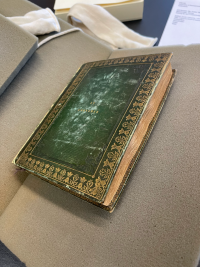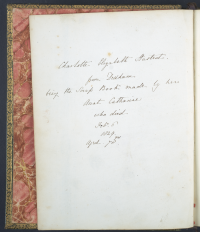Catharine Gould Scrapbook
Introduction

Tucked away in the corners of archives and special collection libraries are a number of old, handmade books that have baffled historians for decades.[1] These books are often hidden under the guise of many names: scrapbooks, albums, commonplace books, blank books. Because these books were never published or circulated in the public sphere, they do not follow the rules and conventions that govern other printed books, providing little information about their production and making it difficult to catalog and understand. At the same time, because of their idiosyncratic and personal nature, these books provide readers with a fascinating glimpse into the inner lives of their makers, offering a snapshot of reading practices at the time of their making.
One such book is Ms. Codex 1860, otherwise cataloged as the Catharine Gould scrapbook, in the Kislak Center for Special Collections, Rare Books and Manuscripts at the University of Pennsylvania. Less than one inch thick, the book is case-bound in lavish green leather and adorned with gold engravings. Inside we find clipped and pasted published poems and images along with a number of handiworks, including handwritten notes, hand drawings and paintings, feathers, pressed flowers and leaves, and locks of hair. Though unusual to modern readers, these items are quite popular and are found in other well-documented historical scrapbooks like Elizabeth Reynolds's A Medley, Anne Wagner's Memorials of Friendship, and the Elizabeth Reynolds scrapbook.[1]

Penn Libraries purchased the book at a 2017 auction at Cheffins, in Cambridge, United Kingdom with the assistance from the Zachs-Adams Rare Book Fund, and it has since remained in the stacks.[2] While the long history of how the book ended up at the auction remains somewhat shrouded in mystery, we could trace its provenance to a woman named Catharine Gould, who lived in Essex County in England from 1751 to 1829. There are no traces of her presence online aside from a will in which she bequeathed her manuscript books to her niece.[3] Indeed, the first page of the scrapbook reads, "Charlotte Elizabeth Hasted from Dedham being the scrapbook made by her Aunt Catharine who died Feb. 6, 1829, aged 78 yrs.”
Even though there is little else we know about this particular book, the note itself provides us with abundant information to begin our investigation of it. The note not only identifies it as a scrapbook, but situates us in England in the late seventeenth and early eighteenth century during the proliferation of print. Drawing from this information, let us now delve deeper to explore the Catharine Gould scrapbook and its personal, cultural, and historical significance.
History of the Genre
It is difficult to place handmade books into genres because each book is different and the categories are changing as we speak. But because the writing on the front page identifies the book as a scrapbook, we might first consider it in light of the scrapbook genre. The Oxford English Dictionary records the first official use of the term “scrapbook” in 1825, though it has appeared in private documents like the 1817 Elizabeth Reynolds scrapbook, which contains similar materials as as the Catharine Gould scrapbook like feathers and watercolor paintings.[4] The general consensus is that the term scrapbook refers to books with contents have been cut and pasted in from other sources.[1]
While the term scrapbook is new to the seventeenth century, the notion of cutting and pasting is not. In fact, the practice is common in the manuscript culture of the commonplace books. Commonplace books are books where the creators write down notable passages from other works and organize them under different categories.[5] We could trace the this practice of collecting and reproducing handwritten passages back to Cicero and Quintilianus, who encouraged students to write on an album, the latin word for “white” that would come to refer to a blank tablet and later a blank book.[6]
Even though both commonplace books and scrapbooks involve filling blank books or albums with materials found elsewhere, there is an important distinction: the scrapbook is composed of printed materials. As a result, scrapbooks are often described as an “industrialized and democratized” form of the commonplace books.[5] This is because as print became cheaper, even people who did not write were then able to preserve materials using scissors and glue. Because of the increased ease and access, we began to see a greater number and variety of sources, which is characteristic of scrapbooks as we know it.[5]
"Books of Scraps"

Beside the unique handiworks in the scrapbook, most pages of the scrapbooks are filled with poems that are foreign to most modern readers. These are not the famous poems that we know from eighteenth-century England. Rather, we find an electric mix of unfamiliar charades, enigmas, epigrams, and hymns excerpted from popular, ephemeral publications of the time, few of which are documented in digital repositories. Out of the 100+ poems I studied, I was able to find two publications that match up with the clippings in terms of their content, layout, and typeface: Volume 21 of The London Magazine, Or, Gentleman's Monthly Intelligencer, and The Norfolk Ladies Memorandum Book; Or, Fashionable Pocket Repository For the Year 1793.
This is the norm and not the exception for scrapbooks in this period. In fact, book historian Ellen Gruber Garvey writes that in all the scrapbooks she studied, “all the classics from the eighteenth century were absent.” Rather, we find items from the “cheaper popular circulation” that are opposed to “the more centralized power of prestigious book and magazine publication."[5] In fact, as the practice of scrapbooking became popular, we saw more collections of poems sold as “book of scraps” meant to be cut out rather than read, cherished, and passed on through generations.[7] Therefore, scrapbooks offer the readers a fascinating glimpse to the other side of popular reading culture that we never knew about.
Because these books are ephemeral and sometimes meant to be taken apart, they are often produced with a low budget. We find that most of the poems in the Catharine Gould Scrapbook are printed with a stereotype caste on a thin paper. As a result, some texts are visible on the other side while others are faded or smudged. The papers themselves are also tinted with a blue color, which is reminiscent of the cheap blue books we find for record-keeping. Yet even though these books cost much less than the printed book that we are used, such books were still expensive for most people.[8] Therefore, most women who create scrapbooks come from upper-middle class, and we might speculate the same for Catharine Gould.
Use & Rearrangement
Readership & Circulation
Authorship & Copyright
Impact & Significance
- ↑ 1.0 1.1 1.2 Deidre Lynch, "Paper Slips: Album, Archiving, Accident," Studies in Romanticism 57, no. 1 (2018): https://proxy.library.upenn.edu/login?url=https://www.proquest.com/scholarly-journals/paper-slips-album-archiving-accident/docview/2061875748/se-2?accountid=14707.
- ↑ "Catharine Gould Scrapbook," Philadelphia Area Archives Research Portal, http://dla.library.upenn.edu/dla/pacscl/detail.html?id=PACSCL_UPENN_RBML_PUSpMsCodex1890.
- ↑ "Will of Catharine Gould, Spinster of Dedham, Essex," The National Archive, https://discovery.nationalarchives.gov.uk/details/r/D259435.
- ↑ "Scrapbook," Oxford English Dictionary, https://www.oed.com/view/Entry/173320?rskey=2ApOj1&result=1&isAdvanced=false#eid.
- ↑ 5.0 5.1 5.2 5.3 Ellen Gruber Garvey, Writing with Scissors (Oxford: Oxford University Press, 2012), https://oxford-universitypressscholarship-com.proxy.library.upenn.edu/view/10.1093/acprof:oso/9780195390346.001.0001/acprof-9780195390346.
- ↑ Susan Tucker, Katherine Ott, and Patricia Buckler, "An Introduction to the History of Scrapbooks," introduction to The Scrapbook In American Life (Philadelphia: Temple University Press, 2006).
- ↑ Deidre Lynch, "Wedded to Books: Nineteenth Century Bookmen at Home," in Loving Literature: A Cultural History (Chicago: University of Chicago Press, 2014), https://doi-org.proxy.library.upenn.edu/10.7208/9780226183848.
- ↑ Stephen Colclough, Consuming Texts: Readers and Reading Communities, 1695-1870 (London: Palgrave Macmillan, 2007).